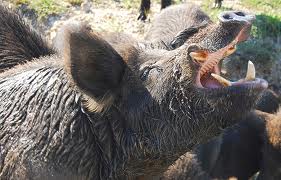Pig Traps - Box, Cage, Corral Hog Traps
While there are only so many places in America where pig traps will give you good results, setting up a large trap with a nearby sounder, or group, will keep you in meat and pig skin for months at a time. The average wild pig weighs over 100 pounds and while you'll find a lot of fat stored away, there's a surprising amount of muscle to be had. This meat will be an excellent source of fat and protein, which in the case of a survival scenario could spell the difference between sickness and health.
Key Features
If you decide to include pig traps as part of your survival plans, you'll need to give the construction some careful consideration. Whatever type of trap you build, it must have the following key features:
- Height - despite looking short and stocky, the average wild pig will be able to jump to a height of at least three or four feet. Many people prefer to have open top pig traps so as not to cause panic to the captured animals, and if this choice appeals to you, you'll need to make sure that the walls are high enough to block any horizontal escape route. The other option is to construct a steel frame to cover the trap, but this will need to be securely fastened for security.
- Strength - the large amount of muscle on each pig means that they are incredibly strong and this strength is only increased by the fear and anger at being captured. Wild pigs are likely to charge the walls of your enclosure looking for a way out so your walls need to be made out of either metal bars or concrete to stand up to the pressure. You will also need to make sure that the corner posts are sunk into the ground with concrete. This will give you a solid structure to build from.
- Underground material - wild pigs are famous for their ability to root and burrow in the ground. This natural instinct comes from their diet of nuts and mushrooms that often lie underground. This instinct also means that once they've exhausted themselves against the walls of your trap, they'll start to dig under the walls. The floor of your trap therefore needs to be made from concrete or other hard material that will stand up to scraping and biting.
Types of Pig Traps
It is possible to make your own hog traps relatively easily, but it can be cheaper and easier to buy one pre made, especially if you want to get everything in place before any apocalyptic event occurs. The most common form of traps for wild pigs include:
- Box trap - these are the most simple form of trap as they have enough room for one pig at a time. There is a simple entrance way and trigger mechanism that drops the door down behind the pig once it enters.
- Cage trap - these are the most common traps as they are cheap to construct out of strong metal wire frames and can hold two or three pigs at a time. The door tends to be propped open by the bait meaning that the pigs have to come in a line to get them all inside. A trail of bait takes care of this problem.
- Corral - if you're trying to catch a whole sounder, a corral trap is the way forward. This is a large enclosure and the closing mechanism is normally done by hand. This will allow you to act more as a pig farmer than hunter as you can let the pigs come and go once they feel safe in that area.
You should research ahead of time if the area around your home or your survival base is suitable for pig traps, both in terms of the land and soil as well as the number of wild pigs that pass through.
Return from Pig Traps to SHTF Survival






New! Comments
Have your say about what you just read! Leave me a comment in the box below.